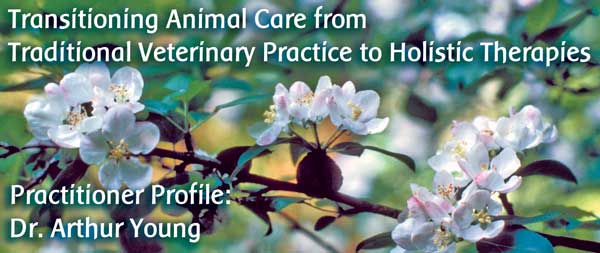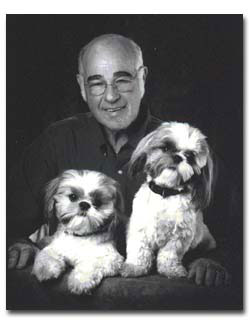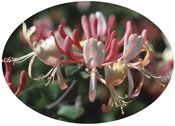|

Above: Crab Apple
By Jann Garitty
 The late
Dr. Arthur Young
had been involved in veterinary medicine for almost 60 years and had decades of experience observing animal patients and the profession as a whole. For 38 years, he practiced traditionally as he was trained to do at the University of Georgia, School of Veterinary Medicine.
The late
Dr. Arthur Young
had been involved in veterinary medicine for almost 60 years and had decades of experience observing animal patients and the profession as a whole. For 38 years, he practiced traditionally as he was trained to do at the University of Georgia, School of Veterinary Medicine.
As a result of his experience and acute observations, in 1990 he underwent “an epiphany, a big ‘aha!’, as they say. At that point in time, he said to himself, ‘why is no one getting better, why are so many coming back with the same or similar diseases? And, if not better, worse in some cases. And the same thing was happening with my colleagues’ clients as well.”
He took a long, hard look and in most of the cases that were difficult, the diseases were “immune mediated.” He thought that they had been over-vaccinated: some animals receive eight vaccinations, meaning eight viruses in their bodies, every year. “Humans would never do that to themselves, nobody in their right mind would do it, but they do it to their animals.”
Further, he thought about inflammation as being one of the body’s main lines of defense. If that is the way the body defends itself, then why would steroids, anti-inflammatorys be utilized? Further still, if the body has its own way of defending itself through a healthy immune system, why then, the constant prescribing of antibiotic after antibiotic?
Witness to the evolution of traditional veterinary practice
“By virtue of my age, having been involved in the veterinary field since 1948 when I started my education, I’ve seen the metamorphosis of veterinary medicine, the wonderful technology and also the terrible impact of drug and vaccination protocols on animal health. The result is that the ill-effects of the drugs may become entrenched in the gene pool. We can easily observe this: a female dog is born, and at one year of age may come into heat and be bred; one year later
her
female puppy might be bred. And ten years later, there are ten generations; humans would take 300 years to produce ten generations. In ten years, with animals, we see all the unfortunate aberrations that may be transferred via the genetic code. It’s a short time and that’s why we’ve been able to observe this frustrating phenomena. At this point in time, many dog breeds are compromised; over the years I’ve watched the genetic demise of many Shi Tzus, Cocker Spaniels, Labradors and Yorkshire terriers, to name a few.”
Dr. Young observes that Dr. J. Compton Burnett in a book written in 1892 (London), first noted the existence of “vaccinosis” (the term given to the chronic reaction of the body against repeated immunization) and he used small pox as an example. As Dr. Young says, “vaccines may often leave their calling cards” and the effect on the genes of the animal populations are in great evidence. Important to note is the fact that in actuality, most of the diseases, except for rabies, for which vaccinations are given, can be treated with homeopathy, including Parvo virus.
In addition to the conceptions discussed above, Dr. Young observed the constant feeding of low quality, commercial foods produced for animals and was struck by the lack of nutritional support that they provided for them. He says at that point, he “switched horses” and learned about glyconutrients and immediately introduced them and raw foods into his practice. He quickly limited his patients’ exposure to vaccines and heat processed diets.
The leap forward toward holistic healing modalities
In 1994, he heard about a course in veterinary homeopathy that was advertised in a holistic magazine. Though he knew absolutely nothing about it, he attended the three day course and has “never been the same since.” In November of that year, he started studying homeopathy with
Dr. Richard Pitcairn
, author of
Dr. Pitcairn’s Complete Guide to Natural Health for Dogs and Cats
, and underwent a year-long training in Boulder, Colorado. In 1996, he received certification from the Academy of Veterinary Homeopathy. He sold his practice in 2000 and started doing homeopathic consultations exclusively by telephone. Dr. Young also lectures and teaches seminars on homeopathy.
While studying with Dr. Pitcairn, Dr. Young learned about the Bach remedies. He recalled the teachings of Dr.
Hahnemann
who stated that 75% of the failures of his cases were due to emotional issues. Dr. Young then incorporated the use of the Bach flower remedies in his practice. He has since recognized them to be great catalysts in allowing the homeopathic remedies to work more efficiently and they “play an enormous role in turning things around. … And, flower essences do not affect homeopathic remedies; there’s no reason not to use them. … The proof of the pudding is that animals respond more efficiently to any treatment protocol.
|
Health is a combination of things: emotional stability, nutritional excellence and the use of non-pharmaceutical ways of ridding a patient of the symptoms of illness.
|
“Health is a combination of things: emotional stability, nutritional excellence and the use of non-pharmaceutical ways of ridding a patient of the symptoms of illness. Of course the symptoms are not the disease, just the language of disease. The body responds as a unit, not in pieces. Modern day medical practice has compartmentalized medicine. But there are trillions of cells in the body and they all respond as a unit. One injury affects every cell in the body. So, we cannot treat with just one modality. If someone is simply treated with just drugs that suppress symptoms, a stimulus may eventually come along and wake the ‘sleeping giant.’”
Educating and working with clients
People locate Dr. Young through word of mouth, the internet, newspaper articles and such. Most of them may not have knowledge of homeopathy or flower essences but they do know their animals need something different. In many cases, they feel desperate in regard to their animal’s condition and know that they don’t want drugs. However, Dr. Young says, “It can be difficult dealing with someone who wants something and wants it
now
. It is a slower process; except for cases of acute injury.”
First off with new patients, Dr. Young works to adjust their diet, including the use of proper vitamins, minerals and digestive support. Every one of Dr. Young’s patients is given a flower essence of some kind depending on their needs, “and all of them have needs—combined with nutrition and homeopathy it’s a ‘god send’ as far as being able to help the animals.” He feels that one must recognize the stress factor in disease cure: if issues of stress are not addressed, then one may not obtain the best possible results with the homeopathic remedies.
To introduce flower essences to someone who has no knowledge of them, Dr. Young will speak of the history of Dr. Bach, his background in homeopathy and the creation of the remedies. He explains that they have an impact on the psyche. He also tells them that one can’t overdose on flowers, which makes a big impression on his clients and it also mitigates safety issues and fears of side effects. “I educate all my patients all the time; if I can’t teach them what I’m doing, then I can’t do well for them. I want them to know what I’m doing and why, and that way I earn their cooperation.”
Flower essences aid animals in relationship with their families
Many animals become ill and remain so when living amidst the constant stress and negative energy of dysfunctional families. Peoples’ anxiety and dysfunction spread out onto their pets; the animals “get it” very clearly. In all such instances involving emotional toxicity, Dr. Young gives
Crab Apple
to his patients, and sees that it makes a tremendous difference for the animals. If nothing else, he recommends
Five-Flower Formula
(Rescue Remedy) for animals in out-of-control dysfunctional families to help them deal with what goes on in their homes every day.
|
|
|
The Five-Flower Formula flowers
From left to right:
Rock Rose, Clematis, Star of Bethlehem, Cherry Plum, Impatiens
|
Dr. Young notes that another aspect of family life in contemporary American society which affects animals is the frequency of moving from house to house, even from one state to another. Animals often don’t do well and he starts them on a combination of
Five-Flower Formula
and
Walnut, many times combined with
Mimulus
and
Aspen.
In multiple pet households, some of which even have up to 5-7 animals, there exists a natural hierarchy amongst them which may cause problems. An “alpha” animal may “trample upon” the other animals. Dr. Young will treat the animal(s) put upon and also the animal causing the difficulty. He uses different essences depending on the causes of the behaviors.
 Living in Florida, Dr. Young has witnessed many retirees whose partners have passed away, and their pets lament the deaths of their owners as well. He quickly recommends
Honeysuckle
(pictured at right)
, noting that a great many illnesses are created because of grief: “The animal experiences a sense of loss. If something is not done, illness may result; grief carries consequences. Flower essences are preventive medicine in these cases.” The same holds true if another animal in the household dies, a “buddy” or mate. The animal may be apathetic, perhaps not eat. Dr. Young will also give the patient
Walnut
as well as
Honeysuckle
to adjust to the situation. “Whenever there’s a sense of loss, flower essences do a wonderful job.”
Living in Florida, Dr. Young has witnessed many retirees whose partners have passed away, and their pets lament the deaths of their owners as well. He quickly recommends
Honeysuckle
(pictured at right)
, noting that a great many illnesses are created because of grief: “The animal experiences a sense of loss. If something is not done, illness may result; grief carries consequences. Flower essences are preventive medicine in these cases.” The same holds true if another animal in the household dies, a “buddy” or mate. The animal may be apathetic, perhaps not eat. Dr. Young will also give the patient
Walnut
as well as
Honeysuckle
to adjust to the situation. “Whenever there’s a sense of loss, flower essences do a wonderful job.”
Commonly used flower essences in practice
· Chronic illness in geriatric patients has a devastating effect on an animal’s ability to get better. In such cases, Dr. Young has found that the combination of
Gorse
and
Gentian
is very helpful. If an animal has “given up,” he gives them
Larch
or
Oak
as well.
· For cats that are very aggressive, that do a lot of biting, and who are very anti- social, the first thing given them is
Holly
and
Beech.
·
Five-Flower Formula,
along with Mimulus, Aspen and homeopathic remedies are routinely given to animals that are fearful of thunderstorms.
· Animals that destroy things are given
Sweet Chestnut.
· Animals that are not able to learn easily are given
Chestnut Bud.
· For skin disease, chronic scratching, or “digging” on themselves,
Agrimony
is prescribed.
· Cats with cardiomyopathy, with enlarged hearts or diseased heart muscle, are given
Mimulus
which has a salutary effect on myopathy; it is specific to heart muscle.
· Animals who are always in a state of agitation, are restless, and those that don’t sleep well, consistently receive good results with flower essences.
·
Agrimony
and
Crab Apple
are given for skin conditions or to birds who “feather pick.”
· For cases of epilepsy or vertigo such as is caused by cerebral vascular accidents or middle ear pathology,
Scleranthus
is effective, it enhances the ability to improve over time and helps to lessen the number of episodes; it helps to establish “equilibrium.”
Methods of administering flower essences
Dr. Young recommends that drops of flower essences be applied on an animal’s ear skin where there is no hair. He uses 3- 6 drops applied three times a day. He will even apply the essences every 15 minutes if an animal is very upset or say for example, has been in a car accident. He says the skin is “like a blotter, the essences go right in and changes can be seen immediately.” The bottle is shaken vertically ten times each day before use.
For birds, he will place drops of essences into their drinking water, put a drop in their beaks or rub it into the skin of their legs.
He also will simply wipe the essences onto the skin of iguanas and snakes, though more often he will put it into an iguana’s drinking water. Dr. Young says “essences work on anything alive; it doesn’t make any difference what it is.”
About Dr. Arthur Young
The late Dr. Arthur Young was nationally known as a practitioner, lecturer, teacher, and author. He had over five decades of experience as a clinician, researcher in diseases of primates, instructor in pathology at the University of Pennsylvania School of Veterinary Medicine, and as an innovator in the application of homeopathic medicines for exotic animals.
|
Dr. Young adheres to the “Rule of 250”—
Everyday in your life, directly or indirectly, you touch the lives and health of 250 people.
If you treat with kindness people who are in trouble emotionally, are angry, depressed or whatever, you contribute to their day and they will feel better. And in turn, they will treat the next people they come into contact with much better than they might have. And then
those
people will be touched by this positive approach; it will go on for the lifetime of this planet ...
If you create unhappiness as a result of your behavior, you will affect people negatively and in turn, you adversely affect their health…
|
|

![]() and then Add to Home Screen.
and then Add to Home Screen.
![]() and then Add to Home Screen.
and then Add to Home Screen.